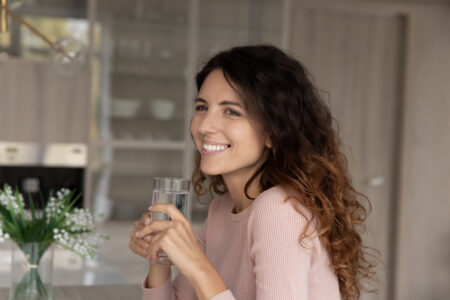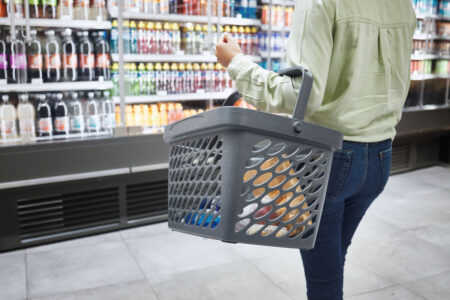
Share On Social!
A hospital is a place for healing illness, and promoting health for new moms.
However, many hospitals across the country still offer a wide range of sugary drinks in vending machines, gift shops, and cafeterias.
Latino kids on average drink more of these sugary drinks their White peers.
One hospital in Boston used a beverage policy to not only help patients make healthy drink choices, but also hospital administration, staff, patients’ families, and the local community.
The Obesity Crisis
Dorchester is a diverse inner-city community in Boston, Mass., where almost 20% of residents are Latino.
Many of Dorchester’s low-income, high-risk factor patients get their medical care at Carney Hospital, a member of Steward Health Care, the largest fully integrated community care organization in New England, and a teaching hospital for nearby Tufts University School of Medicine, said Bill Howland, the director of hospital marketing and communications.
Obesity has emerged as a major problem.
“We, like many inner-city communities, see high rates of obesity,” said Howland, citing higher obesity rates in North and South Dorchester than Boston’s, at around 30% for adults.
In 2011, the City of Boston planned to bar sugary drink sales on city-owned property, inspiring others to rethink how they promoted health locally.
“This was something that the Boston Health Commission had really promoted in the community,” said Michelle Reid, the former manager of community health at Carney Hospital.
Reid said Carney Hospital’s then-president, Bill Walczak, had a background in public health and had worked in the Dorchester community for decades.
“He had seen the toll obesity was taking on this community,” she said.
Because of this, Walczak was particularly motivated to ensure Carney Hospital was supporting the city’s push toward better health, not hindering it.
“The hospital administration realized it was inconsistent that we were serving beverages with sugar that are such an obvious contributor to obesity rates,” Howland said.
Walczak envisioned a potential change: remove all sugary drinks from the hospital campus.
The hospital administration began exploring how to develop and implement a healthy drink policy that affected all aspects of the hospital, from patients and their families to employees and the surrounding community.
Howland said Carney Hospital does a lot of work in the community encouraging healthy habits and educating folks on how to stay healthy. Additionally, because Carney is teaching hospital, students and faculty are regularly on campus.
Removing sugary drinks would give them more “walk the walk” credibility among staff, students, and patients, Howland said.
Both Reid and Howland agree that Walczak was the driving force behind the removal of sugary drinks at the hospital.
“He embraced it and made the call,” Howland said.
But before the policy could become official, the hospital needed to evaluate what drink options were currently available and spread the word about the new changes.
Developing a Healthy Drink Policy
To get the word out about the upcoming changes, hospital administration used the typical channels of employee communications, such as newsletters and discussions with department heads directly who could relay the information to their teams.
They also wanted to make sure patients and visitors knew about the changes.
“We did create some messaging for the high-definition TV screens in our lobby that announced we were going sugar-free,” Howland said.
Reid said Walczak wrote a “letter from the president” that was distributed to their network explaining the rationale behind the beverage changes.
Administrators also had to notify the food service professionals that they no longer needed sugary drinks in vending machines or at functions or meetings.
“You can’t ban sugary drinks in your vending machines and then order them in your catering,” Reid said.
She also said that getting sugary drinks out of the hospital gift shop can be tricky, but fortunately for Carney Hospital, the gift shop didn’t sell any drinks. Reid said this made ensuring the campus was sugar-free a little easier.
But the hospital didn’t have authority over all drinks sold on the property.
A donut shop had contracted with the hospital years before to have a small shop inside the building. Because the contract was already signed and not expiring soon, Reid said that Carney couldn’t force the shop to stop selling sugary coffees and sodas to customers.
Reid and Howland both said the administration worried that people who missed sugary drinks would just go grab one at the donut shop.
Would the donut shop be willing to support the new policy?
Implementing a Healthy Drink Policy
Hospital administration decided to meet with the donut shop manager to see if he would be willing to make some healthy beverage changes.
To Reid’s surprise, the manger was willing to negotiate.
“He was actually really willing to work with us,” she said.
The donut shop manager said he couldn’t take out the sugary coffee drinks, but that he could swap the full-sugar bottled sodas with their diet counterparts.
“You may be surprised at what you can do when you negotiate with your vendors at the hospital,” Reid said.
Meanwhile the administration worked with the hospital’s food service provider to ensure the changes would rollout smoothly.
“We swapped everything out of the cafeteria,” Howland said.
Because Carney Hospital is part of a hospital system, the administration could have waited for the larger system to pass a healthy beverage policy. But Howland said that would have taken a lot of different types of approval, while doing it as an individual hospital, with strong executive support, would make the transition fairly smooth.
“Having that top-down leadership was very important,” he said.
As planned, former Boston Mayer Tom Menino announced his executive order prohibiting the sale, advertisement, and promotion of sugary drinks on city-owned property in May 2011.
The day before the announcement, Walczak announced that Carney Hospital was officially sugar-free.
Only diet sodas, sugar-free drinks, and water are available in vending machines, shops, the cafeteria, and at hospital functions.
The donut shop still sells coffee drinks, but replaced full-sugar sodas with their diet counterparts. Reid cites the donut shop as a particularly important win, considering the administration didn’t think the shop would agree to any beverage restrictions at all.
She advises other hospitals to at least start a conversation with on-campus vendors.
“You may not be able to get everything you want, but they may be willing to work with you on some things,” Reid said.
Popular with Employees
Initially, not everyone embraced the healthier options.
“It wasn’t entirely popular with employees,” Howland said.
But after a month or so, people were used to the changes, Reid said.
Howland says that the new beverage policy is helping reinforce its healthy messages in the community.
“We will be out at community events promoting healthy lifestyles, talking about the issues with sugar and diet in general,” he said. “It obviously gives us some credibility.”
The hospital continues to spread awareness about the health hazards of sugary drinks on campus.
“Periodically we would do some type of healthy drink promotion,” said Howland, like having a display table in the cafeteria with sugar packets representing how much sugar is in a full-sugar soda.
Howland said that any financial hardships caused from the swap were negligible.
In fact, the assistant manager of the hospital cafeteria is a chef by training, said Howland, and the cafeteria has been doing better financial now that he has begun diversifying the menu offerings.
A new president started at Carney Hospital in 2012, and once Howland and others in the administration explained to him the rationale behind the sugary drinks policy, the new president embraced it fully.
The policy has remained in place.
Reid and Howland encourage other hospitals and neighborhood clinics to begin thinking about how they might support a healthy beverage environment that affects not only the hospital but the surrounding community.
“It’s definitely worth the conversation,” Reid said.
Explore More:
WaterBy The Numbers
74
percent
of Latino kids have had a sugary drink by age 2 (vs. 45% of white kids)
This success story was produced by Salud America! with support from the Robert Wood Johnson Foundation.
The stories are intended for educational and informative purposes. References to specific policymakers, individuals, schools, policies, or companies have been included solely to advance these purposes and do not constitute an endorsement, sponsorship, or recommendation. Stories are based on and told by real community members and are the opinions and views of the individuals whose stories are told. Organization and activities described were not supported by Salud America! or the Robert Wood Johnson Foundation and do not necessarily represent the views of Salud America! or the Robert Wood Johnson Foundation.



